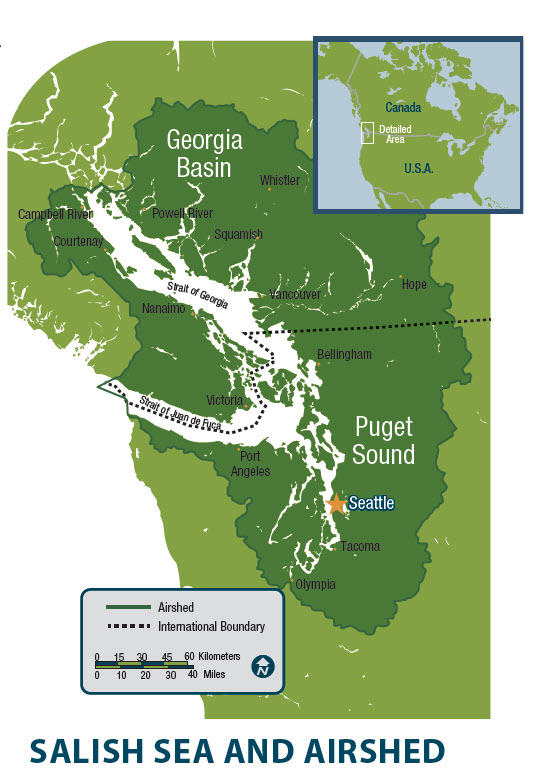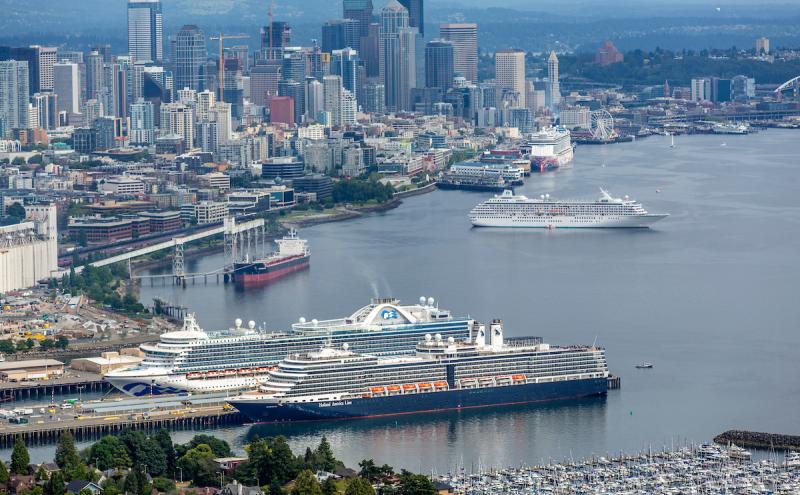
Toward the Greenest Cruise Port in North America
The Port of Seattle is proud to be the largest and fastest growing cruise market on the West Coast. For over 20 years the Port has prioritized protecting the environment while growing cruise to deliver $900 million in annual business revenue to the region during typical operations.
The Port of Seattle is committed to working with our shipping and cruise partners to make Seattle the cleanest, greenest, most energy efficient port in North America.
We’re proud to be the only homeport in North America with a voluntary clean water agreement between the Port, the cruise lines and our regulators. Beyond compliance, the Port works closely with the industry to minimize the climate change and air quality impacts from cruise ship operations through use of cleaner fuels, access to shore power, and a strong collaborative relationship focused on the environment.
Prioritizing Water Quality Protection in Puget Sound
- Cruise ships calling on the Port implement rigorous solid waste handling and recycling programs
- Cruise lines calling on the Port are committed to reducing and eliminating single use plastics
- Since 2004 the Port has partnered with Washington State Dept. of Ecology and the cruise industry in a voluntary agreement, called the Memorandum of Understanding Cruise Operations in Washington State, which helps prevent wastewater discharges from large cruise ships into state waters
- The Port imposes strict stormwater best management practices for cruise vessel operations while at berth
- Starting in 2020, the Port prohibited cruise ships at berth from discharging exhaust gas cleaning system wash water
- In 2021, all ships calling on the Port voluntarily agreed to pause all discharges of Exhaust Gas Cleaning System was water in Puget Sound. This pause will remain in effect until findings from third-party research study can show that was water discharges do not impact Puget Sound water quality and until that tie, cruise ships do not discharge anything into Puget Sound waters.
Partnering with the Cruise Industry to Phase Out Air Pollution and Address Climate Change
Since 2008, the Port has collaborated on the Northwest Ports Clean Air Strategy. The 2020 Strategy sets a bold vision to eliminate air pollution and be carbon free by 2050 and calls for ongoing partnerships and engagement with the cruise industry, governments, community groups, and other ports.
- Since 2005, diesel particulate matter emissions from cruise and cargo ships in Puget Sound decreased 84 percent and greenhouse gas emissions decreased 17 percent
- The Port was an early supporter of international regulations to establish the North American Emission Control Area, which limits the sulfur content in fuels burned in ships when they are within 200 miles of the coast. This regulation has significantly reduced sulfur and diesel particulate matter emissions in Seattle’s Elliott Bay
- The Port provides clean shore power at two cruise berths at Terminal 91, and is on track to add shore power to its third berth by 2023, making all cruise berths shore power capable
- In its first ever Maritime Climate and Air Action Plan, the Port committed to working with its cruise lines to achieve a 100% shore power connection rate by all cruise ships by 2030.
- Shore side, over 90% of the cargo-handling equipment at Port’s cruise terminals are powered by fuels like electricity or propane
- The Port is partnering with its electric utility and waterfront industry to complete a Seattle Waterfront Clean Energy Strategic Plan, which will holistically identify the policies, technologies and investments needed to deploy zero-emission infrastructure—including shore power—and to enable the transition to zero-emission maritime equipment and operations by midcentury
- In 2022, the Port joined 14 other organizations in creating the world's first cruise-focused Green Corridor, developed to explore decarbonization strategies from the Pacific Northwest to Alaska
Cruise Is a Key Port Industry
Seattle’s cruise industry is a major economic driver for the region, providing over 5,500 jobs and nearly $900 million in the region during typical operations. The Port of Seattle can handle some of the largest vessels in the world, with a natural deep-water port, and award-winning world-class cruise facilities. Port of Seattle cruise terminals offer convenience in a spectacular setting with two cruise terminals located on the downtown waterfront, including easy access to Seattle-Tacoma International Airport and Seattle’s famous waterfront attractions.




